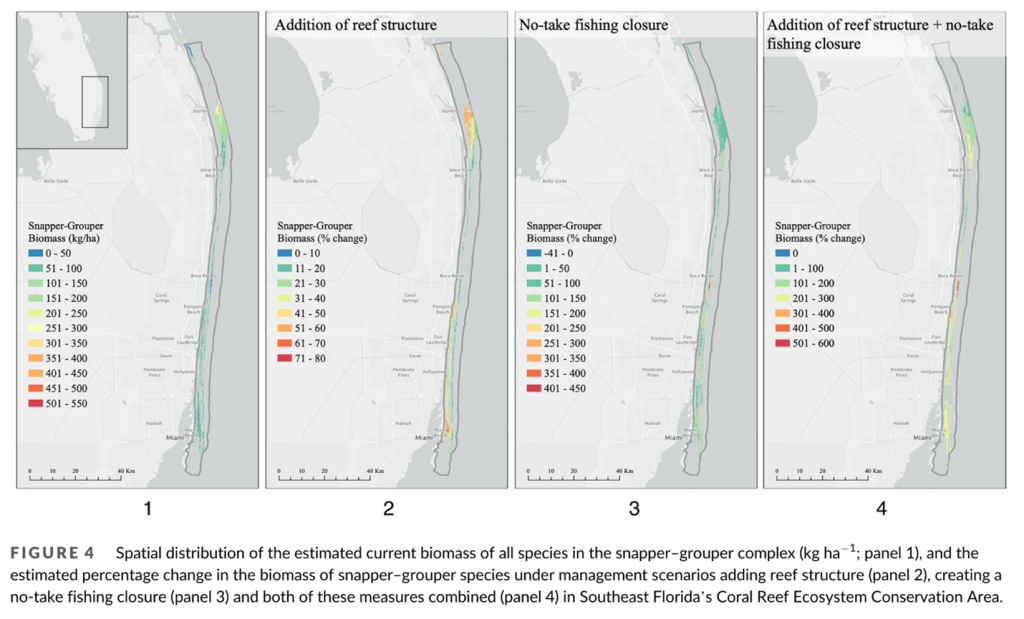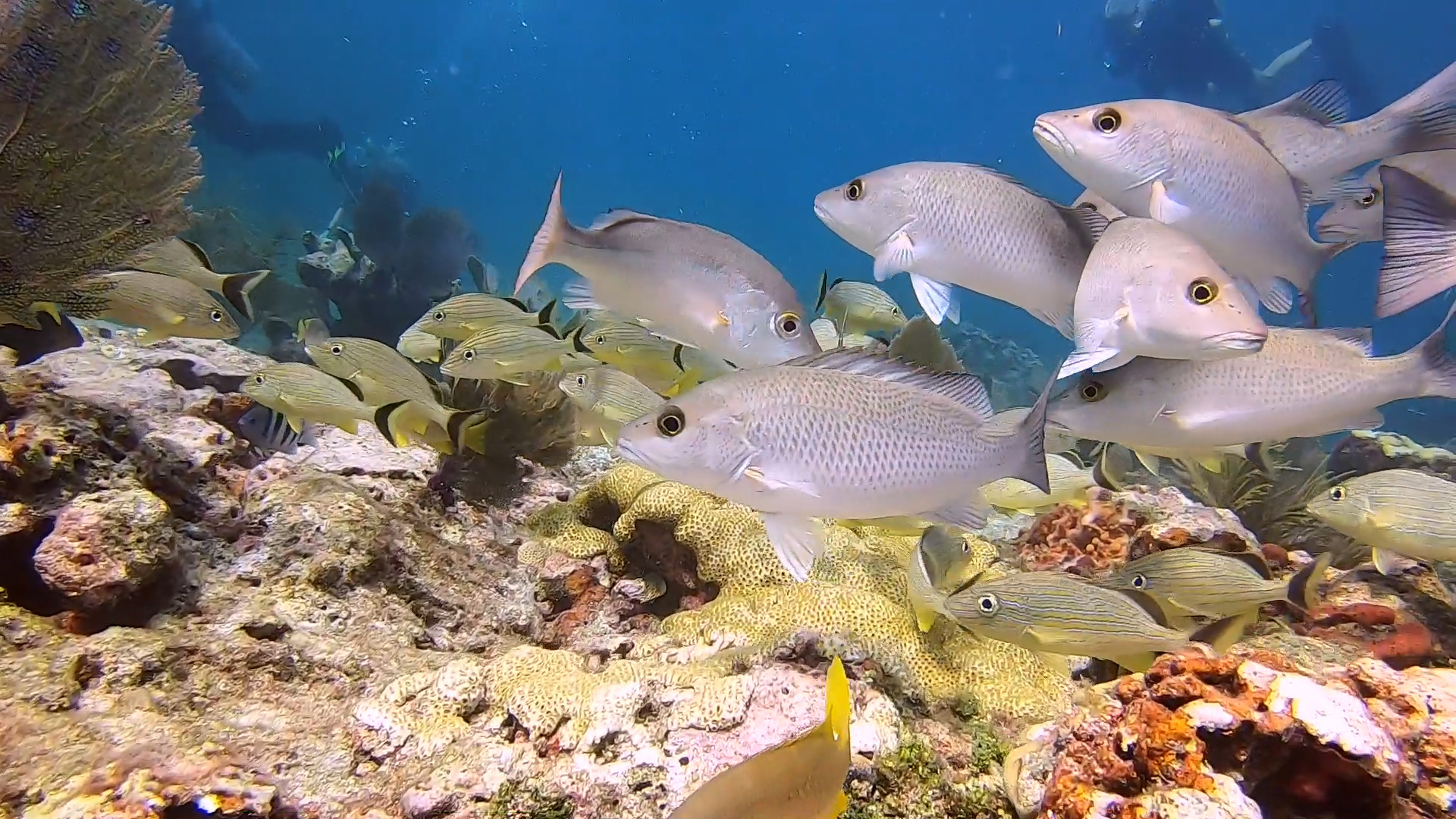New research: Identifying correlates of coral-reef fish biomass on Florida’s Coral Reef to assess potential management actions
The Nature Conservancy collaborated with scientists from the Tropical Fish Ecology Lab at Florida International University to model and map cumulative fishing impact and reef fish biomass on Florida’s Coral Reef. The research, recently published in Aquatic Conservation: Marine and Freshwater Ecosystems provides key insights to the potential benefits of management interventions for increasing coral reef fish populations in the state of Florida.
The management of coral reef fisheries is often made more difficult by a lack of understanding of the local factors that determine fish biomass and by a limited ability to predict the outcomes of management. This project addresses these challenges. Researchers first used models to build an understanding of the major factors that determine the amount of fish found on any given area of reef. They did this using data from more than 2,700 fish surveys and biophysical and social GIS layers to develop a model of fish biomass. Researchers then used these models to create maps that show estimates of current fish biomass (i.e., how many kg of fish are present on a section of reef) for the entirety of Florida’s Coral Reef, even those sections where no fish surveys have been done. Finally, they re-ran the models with simulated management scenarios – coral reef restoration, a no-take fishing closure, and the addition of artificial reef structure – to create maps that show potential increases in fish biomass if these management measures were implemented. The models were run for four reef fish species groups: the snapper-grouper complex (commonly targeted by commercial and recreational fishers); herbivorous fishes (largely unfished and very important for ecosystem health); species in the marine life complex (saltwater fishes harvested for commercial wholesale and retail aquarium dealers); and total biomass (all species documented in underwater fish surveys).
Results confirmed well-known relationships between reef structural complexity, depth and fish biomass, and confirmed strong relationships between several proxies of fishing and the biomass of targeted species (such as snappers and groupers). The research also showed that, of the management scenarios tests, the addition of artificial structure has the highest potential to increase the biomass of the heavily fished snapper-grouper species complex. Importantly, the work provides new evidence indicating positive synergistic effects of combining habitat-based management interventions (such as coral restoration) with limits on fishing. For these combined scenarios, researchers were able to simulate a reef-wide averaged 89% increase in biomass relative to current estimated levels. (see figure below for a subset of research results).

(Figure reproduced directly from Zuercher et al. 2023)
This new information can be used to help set realistic expectations for area-based management outcomes and aid in restoration decision-making. “There is no one-size-fits-all approach to managing coral reef fisheries or increasing fish populations in heavily-fished areas. Our research results take local environmental conditions and details about the human uses of Florida’s Coral Reef into account to tailor predictions about the outcomes of management to specific regions, such as Biscayne National Park or Southeast Florida’s Kristin Jacobs Coral Reef Ecosystem Conservation Area (the ‘ECA’)” says researcher Alastair Harborne. The researchers’ intent was to provide information to managers and stakeholders to improve their understanding of both ecological trade-offs and potential benefits predicted under different management and ocean use scenarios. Their results suggest that conservation strategies aimed at protecting and increasing structural reef complexity should be an important part of fishery management discussions.
Designed in collaboration with The Nature Conservancy, the Florida Fish and Wildlife Conservation Commission (FWC), and other experts, the research furthers our understanding of the ecology of Florida’s coral reef ecosystems while translating the information into predictions directly relevant to conservation. “We prioritized ecologically and economically important fish species groups for modelling, and we designed the modelled scenarios to match actual proposed management approaches.” says researcher Rachel Zuercher, “Our hope is that when paired with other knowledge sources, the maps and models we’ve developed can aid decision-makers as they consider actual proposals to protect coral reefs and the iconic reef fisheries of South Florida.”
The Nature Conservancy’s South Florida Marine Program Manager, Caitlin Lustic, says the time is ripe for the information provided by the model and mapping. “Right now, the Florida Keys National Marine Sanctuary is nearing completion of an overhaul of its regulations and management plan, and the management planning process for the ECA’s first plan is underway. Understanding how coral reef restoration could impact our reef fish populations is also particularly timely as we work with reef managers to develop a restoration plan for the ECA.”
The open-access journal article with detailed methods and results can be found here. To explore the data, visit the Coral Reef Fisheries app on the Mapping Ocean Wealth website.
Photo credit:© Rachel Hancock Davis
Citation: Zuercher, R, D Kochan, R Brumbaugh, K Freeman, R Layko, A Harborne. 2023. Identifying correlates of coral-reef fish biomass on Florida’s Coral Reef to assess potential management actions. Aquatic Conservation: Marine and Freshwater Ecosystems 33(3):246-263.


